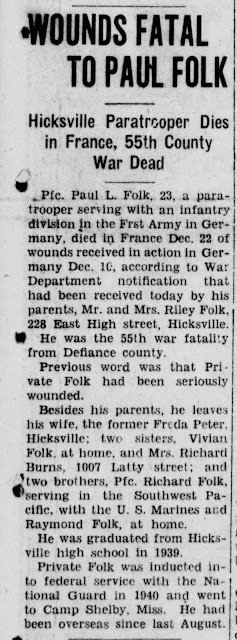PFC Paul Lemuel Folk
Paul lived on Spencerville Street in Hicksville, Ohio, with his parents, Riley R. and Goldie Marie (Houser) Folk.
Born on December 1, 1921, in HIcksville, Paul was a graduate of Hicksville High School in 1939. He married Freida Mae Peter and joined the National Guard after graduation, assigned to Company A, 148th Infantry Regiment, 37th Army Infantry Division.
Kent Miller, local historian, wrote in his biography of Paul featured in the Hicksville News-Tribune:
"(Folk) was with the 37th when it was federalized in September of 1940 and traveled with the unit to Camp Shelby, Mississippi, for training. He made Corporal in August of 1941 and was promoted to Sergeant in
January 1942.
and preparing for deployment overseas, he was accepted into
Officer Candidate School. He attended classes at Fort Benning, Georgia and, upon completion of the course, was made a Second Lieutenant. He was placed in the finance branch and remained at Fort Benning to serve.
For some unknown reason, he signed his commission and returned to Hicksville. In January 1944, he reenlisted in the Army and trained as a paratrooper at Camp Blanding, Florida and Fort Meade, Maryland. In August of that year, Folk was sent to Europe as a replacement paratrooper and was then assigned to the 11th Airborne Division as a Private First Class.
By late November 1944, PFC Folk was again moved, this time to Company E, 39th Infantry Regiment, 9th Infantry Division. On December 4th, the 9th received orders to leave for Eschweiler to relieve the 1st Division along the edge of the Huertgen Forest.
The Division moved out on December 5th with the command post situated at Bergrath, Germany. By the evening of December 7th, the unit was in place west of the Knozendorf-Ehta-Schlikch-Merode area.
On December 10th, 1944, the 39th Infantry Regiment was to attack east from the vicinity of Jungersdorf along a rail line which paralleled a highway. Their objective was to capture the town of D'Horn. The Regiment began to move forward at 3:15 P.M. Fighting was fierce, and while the town was secured by nightfall, Folk was seriously injured during the advance.
PFC Paul Folk was evacuated to a field hospital and later transported to the 40th General Hospital. His right foot was amputated to stem the spread of gangrene, but on December 22, 1944, Folk died of his wounds. Official cause of death was listed as gas gangrene, and he was buried in an Allied Cemetery, Solers, France. In September of 1948, Folk was reinterred at Epinal American Cemetery at Epinal, Lorraine, France."
Kent Miller, The Hicksville-Tribune
 |
| Crescent-News, Jan. 12, 1945 |
 |
| Epinal American Cemetery and Memorial, Lorraine, France |
Dianne Kline, Researcher
Thanks to Kent Miller, Researcher



















.jpg)

























